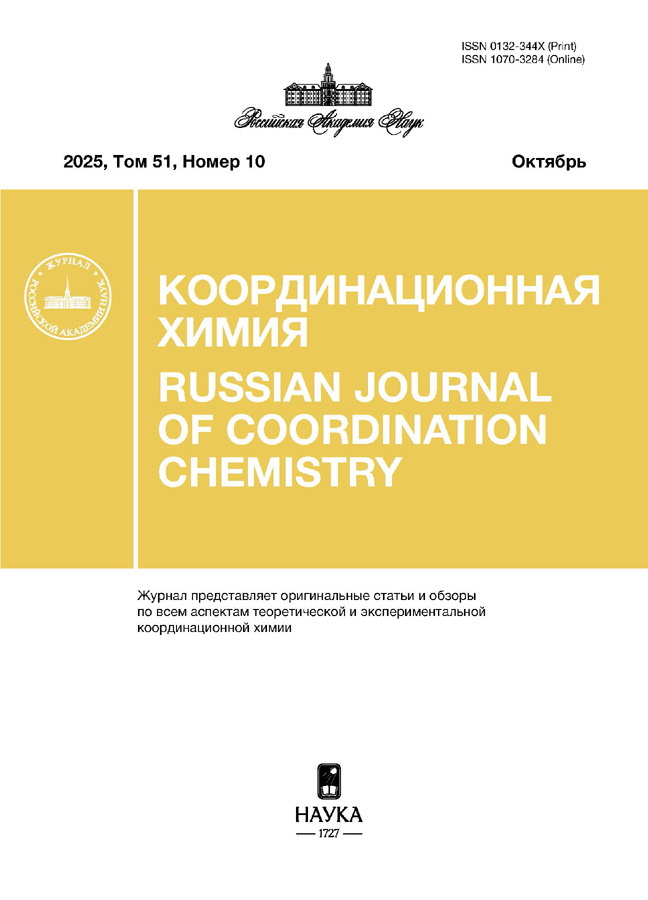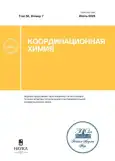Nickel(II) and Copper(II) Dicyanoargentate Complexes with Ethylenediamine and 4,4´-Bipyridyl Ligands
- Authors: Pashnin D.R.1, Shevchenko D.P.1, Sharutin V.V.1, Sharutina O.K.1
-
Affiliations:
- South Ural State University (National Research University)
- Issue: Vol 50, No 7 (2024)
- Pages: 460-468
- Section: Articles
- URL: https://gynecology.orscience.ru/0132-344X/article/view/667589
- DOI: https://doi.org/10.31857/S0132344X24070053
- EDN: https://elibrary.ru/MUBIHC
- ID: 667589
Cite item
Abstract
The reactions of an aqueous solution of potassium dicyanoargentate with a mixture of nickel(II) or copper(II) chloride and ethylenediamine or 4,4´-bipyridyl in ethanol afford coordination polymers [Ni(En)2(Ag(CN)2)][Ag(CN)2] (I), [Cu(En)2(Ag(CN)2)][Ag(CN)2] (II), and [Cu(4,4´-Bipy)2(Ag(CN)2)2] (III) characterized by XRD (CIF files CCDC nos. 2225984 (I), 2214320 (II), and 2229270 (III)) and IR spectroscopy. According to the XRD data, the crystals of complexes I and II are formed by 1D chains {··NC– Ag–CN–M(En)2··}n (M = Ni (I), Cu (II)) linked with each other by the dicyanoargentate anions via argentophilic contacts (Ag···Ag 3.288(8) Å (I), 3.1616(14) Å (II)). The crystal of compound III consists of independent interpenetrating 3D networks built of polymer layers {Cu[Ag(CN)2]2}n bound to each other by the 4,4´-bipyridyl molecules. The bipyridyl linkers connect the Cu centers with the Ag centers of the [Ag(CN)2]– anions thus providing the tridentate coordination of the silver atoms. No Ag···Ag interactions are observed in the crystal of complex III.
Full Text
About the authors
D. R. Pashnin
South Ural State University (National Research University)
Email: Shepher56@gmail.com
Russian Federation, Chelyabinsk
D. P. Shevchenko
South Ural State University (National Research University)
Author for correspondence.
Email: Shepher56@gmail.com
Russian Federation, Chelyabinsk
V. V. Sharutin
South Ural State University (National Research University)
Email: Shepher56@gmail.com
Russian Federation, Chelyabinsk
O. K. Sharutina
South Ural State University (National Research University)
Email: Shepher56@gmail.com
Russian Federation, Chelyabinsk
References
- Batten S.R., Champness N.R. // Phil. Trans. R. Soc., A. 2017. V. 375. Art. 20160032. https://doi.org/10.1098/rsta.2016.0032
- Furukawa H., Cordova K.E., O´Keeffe M., Yaghi O.M. // Science. 2013. V. 341. № 6149. Art. 1230444. https://doi.org/10.1126/science.1230444
- Liu J., Chen L., Cui H., Zhang J. et al. // Chem. Soc. Rev. 2014. V. 43. № 16. P. 6011. https://doi.org/10.1039/C4CS00094C
- Zhang H., Cai J., Feng X.-L et al. // Inorg. Chem. Commun. 2002. V. 5. № 9. P. 637. https://doi.org/10.1016/S1387-7003(02)00514-2
- Lin Y.-Y., Lai S.-W., Che C.-M et al. // Inorg. Chem. 2005. V. 44. № 5. P. 1511. https://doi.org/10.1021/ic048876k
- Marinescu G., Madalan A.M., Andruh M. // J. Coord. Chem. 2015. V. 68. № 3. P. 479. http://doi.org/10.1080/00958972.2014.997721
- Wang J.-Y., Zhang L.-Z., Gu W et al. // J. Coord. Chem. 2006. V. 59. № 15. P. 1685. http://doi.org/10.1080/00958970600580142
- Wang J.-Y., Gu W., Wang W.-Z et al. // Chin. J. Chem. 2006. V. 24. № 4. P. 493. https://doi.org/10.1002/cjoc.200690095
- Baril-Robert F., Li X., Katz M.J et al. // Inorg. Chem. 2011. V. 50. № 1. P. 231. https://doi.org/10.1021/ic101841a
- Galet A., Niel V., Muñoz M.C., Real J.A. // J. Am. Chem. Soc. 2003. V. 125. № 47. P. 14224. https://doi.org/10.1021/ja0377347
- Wang L.-F., Zhuang W.-M., Huang G.-Z et al. // Chem. Sci. 2019. V. 10. № 32. P. 7496. https://doi.org/10.1039/c9sc02274k
- Gural´skiy I.A., Shylin S.I., Golub B.O et al. // New J. Chem. 2016. V. 40. № 11. P. 9012. https://doi.org/10.1039/C6NJ01472K
- Arcís-Castillo Z., Muñoz M.C., Molnár G. et al. // Chem. Eur. J. 2013. V. 19. № 21. P. 6851. https://doi.org/10.1002/chem.201203559
- Yoshida K., Akahoshi D., Kawasaki T et al. // Polyhedron. 2013. V. 66. P. 252. http://doi.org/10.1016/j.poly.2013.05.003
- Liu W., Peng Y.-Y., Wu S.-G. // Angew. Chem. Int. Ed. 2017. V. 56. № 47. P. 14982. http://doi.org/10.1002/anie.201708973
- Etaiw S. El-din H., El-bendary M.M. // Inorg. Chim. Acta. 2015. V. 435. P. 167. http://doi.org/10.1016/j.ica.2015.06.020
- Karadağ A., Korkmaz N., Aydin A. , Tekin Ş., Yanar Y., Yerli Y., Korkmaz Ş.A et al.. // New J. Chem. 2018. V. 42. № 6. P. 4679. https://doi.org/10.1039/c7nj04796g
- Korkmaz N., Karadağ A., Aydin A. et al. // New J. Chem. 2014. V. 38. № 10. P. 4760. https://doi.org/10.1039/c4nj00851k
- Korkmaz N. // Turk. J. Chem. 2020. V. 44. № 4. P. 1110. https://doi.org/10.3906/kim-2004-42
- Sharutin, V.V. Sharutina O.K., Popkova M.A., et al. Russ. J. Inorg. Chem., 2019, vol. 64, no. 12, p. 1548. https://doi.org/10.1134/S0044457X19120158
- Sharutin V.V. and Popkova M.A. Vest. YuUrGU. Ser.Khim., 2019, vol. 11, no. 2, p. 5. https://doi.org/10.14529/chem190201
- Popkova M.A. and Sharutin V.V., Vest. YuUrGU. Ser. Khim., 2021, vol. 13, no. 4, p. 110. https://doi.org/10.14529/chem210409
- SMART. SAINT-Plus. V. 5.0. Data Collection, Processing Software for the SMART System, Madison (WI, USA): Bruker AXS Inc., 1998.
- SHELXTL/PC. V. 5.10. An Integrated System for Solving, Refining, Displaying Crystal Structures from Diffraction Data, Madison (WI, USA): Bruker AXS Inc., 1998.
- Dolomanov O.V., Bourhis L.J., Gildea R.J. et al. // J. Appl. Cryst. 2009. V. 42. P. 339. https://doi.org/10.1107/S0021889808042726
- Černák J., Chomič J., Gravereau P. et al. // Inorg. Chim. Acta. 1998. V. 281. № 2. P. 134. https://doi.org/10.1016/S0020-1693(98)00156-X
- Suárez-Varela J., Sakiyama H., Cano J., Colacio E. // Dalton Trans. 2007. № 2. P. 249. https://doi.org/10.1039/B611684A
- Pretsch E., Buhlman P., Affolter C. Structure Determination of Organic Compounds. Tables of Spectral Data. Springer, 2000.
- Nawaz S., Ghaffar A., Monim-ul-Mehboob M. et al. // Z. Naturforsch. B. 2007. V. 72. № 1. P. 43. https://doi.org/10.1515/znb-2016-0154
- Bondi A. // J. Phys. Chem. 1964. V. 68. № 3. P. 441. https://doi.org/10.1021/j100785a001
- Niel V., Muñoz M.C., Gaspar A.B et al. // Chem. Eur. J. 2002. V. 8. № 11. P. 2446. https://doi.org/10.1002/1521-3765(20020603) 8:11<2446::AID-CHEM2446>3.0.CO;2-K
- Soma T., Yuge H, Iwamoto T. // Angew. Chem. 1994. V. 106. № 15–16. P. 1746. https://doi.org/10.1002/ange.19941061547
Supplementary files












